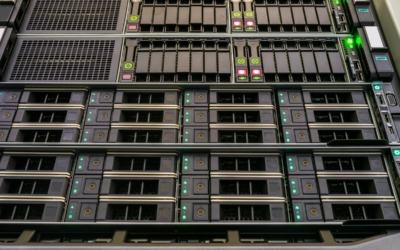Airflow Management Through the Years – Part 1: The Birth of Aisle Separation15 min read

Data center airflow management first became a conversation point back in the mid 1990’s when Robert “Dr. Bob” Sullivan recognized the futility of the then common practice of organizing computer rooms with all racks facing front, and implemented the first “intentional” hot aisle/cold aisle organization of server racks. Having established the value of separating cold aisles from hot aisles, a science of best practices quickly emerged to optimize the benefits of that separation. These best practices included guidelines for minimizing interference to airflow under raised floors, proper location of data center precision cooling units to reduce dragging return air across cold aisles, restricting perforated floor tiles to cold aisles, plugging floor tile cut-outs with brush grommets, and employing blanking panels in all unused rack spaces in racks and cabinets. Ironically, the use of blanking panels pre-dated their airflow management application by nearly a decade, as they were originally developed to complete the aesthetic dress-out of racks and served advertising and branding functions well before they became redefined as a critical element of a total airflow management solution.
Around the same time that airflow management was becoming a science about the proper execution of a hot aisle/cold aisle organization scheme, there were other airflow management practices widely deployed that did not align well with the nascent understanding of these aisle dynamics. Eventually, albeit slowly, they would become purged from common practice. The most common and simultaneously wrong-headed of these practices was the use of fan trays in the tops of server cabinets to remove hot air from those cabinets. Originally, these fan kits addressed the same problem solved by hot aisle – cold aisle row deployment – when all the cabinets or racks were facing in the same direction, hot exhaust air would be evacuated out of the back of one row of equipment and be ingested by the next row of equipment, and so on, until the last row of equipment was a train wreck of thermal failures or warnings. One solution to this condition was to put equipment in closed cabinets rather than open racks and add fan kits to the tops of those cabinets to try to keep the warm air stratified high enough in the room so it would not adversely affect the supply air temperature delivered to equipment. The only reason this approach appeared to work was that, at the time, per-cabinet load densities were typically 2kW or lower. Nevertheless, closer examination revealed this was a counter-productive practice, despite the fact that all rack manufacturers at the time provided fan trays and the attachment rate correlated closely to the percentage of racks loaded with active equipment versus connectivity.
Not only did rack top fan kits distribute hot waste air equally toward the fronts of cabinets and the backs of cabinets, they also contributed to short cycling bypass air past any top-mounted equipment. And if that wasn’t bad enough, the use of these top-mounted fan kits continued into the era of hot aisle/cold aisle, thereby undoing much of the separation intended by such rack-alignment. Once the industry started to understand how top mounted fans were counter-productive to the purpose of hot aisle/cold aisle separation, many data center workers and equipment providers held on to the notion that evacuating hot air from the cabinets was still the problem that needed to be solved and we saw several vendors introduce rear door-mounted fan kits to remove that waste air from the cabinets and into the hot aisle.
Despite server manufacturer’s assertions that server fans were designed to overcome the pressure head of 60% open perforated front and rear cabinet doors, many data center operators drew comfort from all the extra fans and manufacturers did not vigorously object to taking their money. While such fan kits were obviously superfluous in an ideal server world, there were many large gaps between that ideal and the reality where articulated cable management arms and the industry-standard 30” and 36” deep cabinets were crammed full of cabling and power strips, all of which impeded airflow and thereby sometimes established a real value for those door-mounted fan kits. In addition to these evacuation fans, we also saw supply fans built into the bottom of server cabinets or installed in front doors that functioned as plenum extensions to the underfloor space. These fan systems were intended to compensate for irregularities in underfloor static pressure and the effects of hot air re-circulation resulting from the imperfections in separation created by hot aisle/cold aisle layouts.
This is the 1st installment of our 3-part series titled: Airflow Management Through the Years
The industry's easiest to install containment!
AisleLok® solutions are designed to enhance airflow management,
improve cooling efficiency and reduce energy costs.
The industry's easiest to install containment!
AisleLok® solutions are designed to enhance airflow management,
improve cooling efficiency and reduce energy costs.

Ian Seaton
Data Center Consultant
Let's keep in touch!







0 Comments